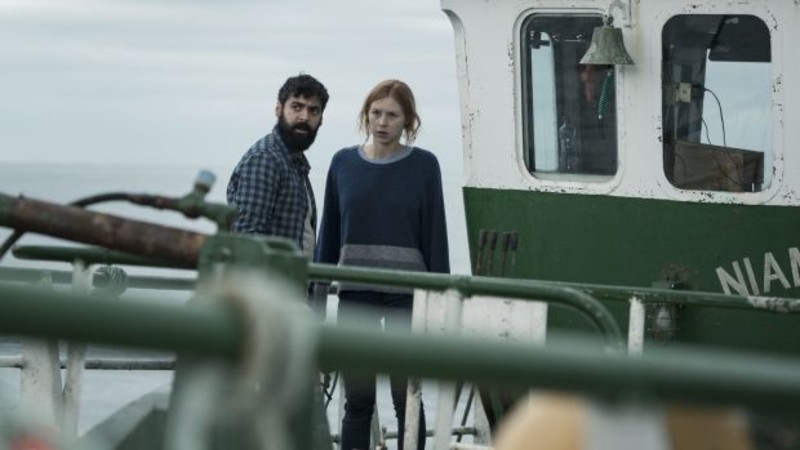When a trawler hits an unseen object and becomes marooned, marine biology student Siobhan’s (Hermione Corfield) research excursion takes an unexpected twist. As the crew of six, led by husband and wife Gerard (Dougray Scott) and Freya (Connie Nielsen), learn that a mysterious water-borne parasite has infected their water supply, they find themselves in a struggle for survival.
“Blessed is he who expects nothing, for he shall never be disappointed” are the words of English poet Alexander Pope. If expectation is absent, this offers no assurance that one will avoid feeling disappointed by a film. Not only are we cineliterate, but we have unconscious or subliminal desires that we are not always fully aware of. The marketing of a film, a still image, the briefest of a synopsis constructs narrative expectations that we then judge the film against. The tussle between the story and the audience, is whether the latter will accept the story the filmmaker has chosen to tell, and critique it by those creative choices, and not by their expectations.
Sea Fever is a familiar story, the type we are most critical or unforgiving towards if it does not satisfy our desire in its approach. In genre cinema the theme of survival is a common one, and here for the conflict of man versus monster, writer and director Neasa Hardiman favours the psychological and human drama over the spectacle of the creature. It is a choice the filmmaker commits to, her attention dedicated to constructing the suspense, the terror lurking offscreen with only glimpses of the creature and its parasitic spores.

This approach will not satisfy everyone’s preferred choice of claustrophobic survival out at sea. Some audiences will want a visually aggressive struggle, while others will appreciate this alternative approach. But then, this is an archetypal story with a flexibility, that can serve different branches of the genre tree. The premise alone sets up expectations of a horror film, but reducing the emphasis on the parasite as an onscreen antagonist, while it has a shade of psychological horror, Sea Fever is at its heart a thriller.
It takes time for the film to make its point, only revealing its conviction in the third act when it addresses the moral conflict of one’s self-preservation, or the survival of the few versus the welfare of the collective. Hardiman places a pressure on the characters to carry the film, and with patience and conviction, Sea Fever gradually emerges as an effective and prescient piece of filmmaking, in pandemic stricken 2020.
The reliance on Siobhan’s scientific knowledge by the trawler crew mirrors our deference to science and medicine to combat the Covid-19 pandemic, while the conflict over self-isolation or self-quarantine to prevent the spread of the parasite to the mainland grows increasingly relevant. With much of the world in lockdown, and demonstrations in opposition to these measures in U.S states, including: Arizona, Colorado, Montana and Washington State, brings an urgent authenticity to the moral conflict that arises in the films third act. And amidst this question of the welfare of the few versus the many, the circumstances under which the trawler becomes marooned, latches on to the tension unfolding in America, of the welfare of the economy over the welfare of the nation’s health.

So, what should one expect from Hardiman’s feature directorial debut? Removed from the shadow of the pandemic, Sea Fever may resonate less strongly – a modestly effective survival at sea story. However, outside of the present crisis, the film is an effective, albeit a quiet and unassuming piece of genre filmmaking. It is emotionally tempered, the top never taken off of the suspense, instead the filmmaker follows a series of cause and effect choices that threads the narrative together.
Gerard defies instructions to not enter a restricted area, which brings them into contact with the parasite. Yet without the promise of the haul from the restricted area, he and Freya will lose their trawler. Siobhan is meanwhile forced to leave the lab by her tutor for a mandatory research excursion. Choice is an intriguing antagonist at the heart of Sea Fever – choice not always our own, and is sometimes a response to pressure. What it strikes at is the issue of co-dependency and the futile nature of individualism. Gerard’s choice plunges his crew into a struggle for survival, while Siobhan’s tutor forces her to leave her introverted comfort zone, and the moral conflict over quarantine is one of the welfare of the individual over the collective on yet a bigger scale.
Sea Fever has a timid feel for a genre picture, and if its themes and ideas are dramatic, the restraint towards emotion compliments the ideas by not reducing human angst to a spectacle of high emotion. The film is observing and commenting on society, looking to human tendencies and the ongoing struggle for humans to embrace the collective over their individual needs, spurred on by the primitive survival instinct that fuels the desperation here. Hardiman also acknowledges man’s arrogance as a precursor to his own downfall, and the ignorance towards our role as part of a larger ecosystem. And yet, she infuses the film with a sympathetic and optimistic heartbeat by its end.
Signature Entertainment presents Sea Fever on Blu-ray & Digital HD from April 24th.








